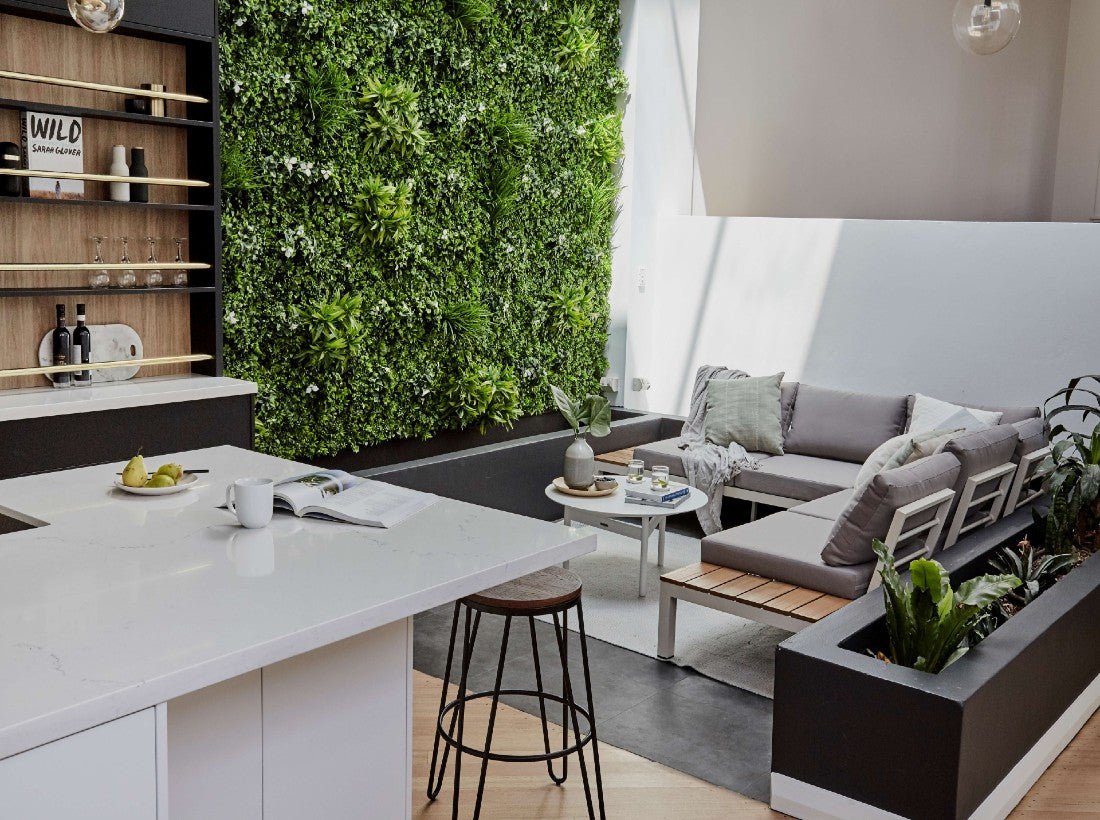El Feng Shui, una práctica que ha guiado la disposición de los espacios durante milenios, también ha influido silenciosamente en cómo diseñamos y vivimos en nuestros hogares.
Este arte ancestral, arraigado en una profunda comprensión de la naturaleza, ha moldeado palacios, viviendas humildes y espacios comerciales para lograr el equilibrio. Los principios del Feng Shui influyen significativamente en diferentes aspectos de nuestra decoración, incluyendo la vegetación artificial.
Con la creciente popularidad de la imitación de lis en los interiores modernos, cabe preguntarse: ¿son las plantas artificiales un mal feng shui? ¿Cómo usar plantas artificiales para un buen feng shui?
Hemos encontrado las respuestas a todas estas preguntas y más. Pero empecemos por el principio.
¿Qué es el Feng Shui?
El feng shui es una antigua práctica china que consiste en organizar edificios y objetos, o decorar espacios, para lograr armonía. También llamada geomancia china, sus orígenes se remontan al año 5000 a. C.
La práctica estaba arraigada en muchas culturas chinas, en particular en las cercanas al río Amarillo. Aunque su origen era anterior, el feng shui floreció durante la dinastía Zhou. En aquella época, los chinos creían que la tierra reflejaba el cielo y que todo en la naturaleza estaba interconectado. Esta creencia dio origen a la idea de que los humanos debían fomentar esta conexión, aplicando los principios del feng shui a la vida cotidiana.
El término "feng shui" se traduce como "viento y agua" y simboliza buena salud. Con el tiempo, esta práctica se convirtió en sinónimo de buena fortuna. En esencia, el feng shui se centra en el flujo de energía y en cómo la disposición de los objetos puede influir en nuestro bienestar y nuestras emociones.
Feng Shui y plantas
Las plantas desempeñan un papel vital en el feng shui. Son canales de crecimiento, vitalidad y prosperidad. En el feng shui de plantas, su ubicación en un espacio contribuye al flujo de energía positiva, o "chi".
La base del feng shui para plantas es la idea de que equilibran las fuerzas en una habitación y aportan buena energía. Por lo tanto, el feng shui para plantas consiste en usar intencionalmente plantas para crear equilibrio, mejorar el flujo de energía y fomentar el bienestar.
Pero ¿se extiende esta narrativa a las plantas artificiales?
¿Son las plantas artificiales un mal feng shui?
No. Las plantas artificiales no son un mal feng shui.
Tradicionalmente, el feng shui ha enfatizado el uso de plantas para generar energía positiva. Sin embargo, a medida que nuestro estilo de vida y hábitos han evolucionado, la comprensión del feng shui de las plantas artificiales también ha cambiado.
Aunque algunos piensan que las plantas artificiales son un mal feng shui porque no están vivas, esa opinión se basa en mitos. El feng shui, de hecho, favorece a las plantas naturales porque forman parte de la naturaleza misma. Pero si no tienes las condiciones o la mano verde para cuidarlas, es mucho mejor tener una alternativa artificial con la misma apariencia que una planta muerta.
Los asesores de feng shui serán los primeros en aconsejarte que deseches cualquier planta marchita o moribunda en cuanto veas que ya no queda nada. El objetivo de tener plantas en casa es mantener el "chi". Las plantas muertas no pueden mantener ninguna energía, y mucho menos una positiva.
Las plantas artificiales no pueden causarte tal problema. Por lo tanto, son una apuesta segura para quienes abusan de las plantas y desean adherirse a los principios del feng shui.
¿Cómo utilizar plantas falsas para un buen Feng Shui?
Incorporar plantas artificiales según el feng shui en tu espacio vital o de trabajo es una manera fácil de lograr el equilibrio. Por suerte, no necesitas conocimientos de diseño de interiores para usar plantas artificiales y lograr un buen feng shui.
Incluso sin la energía natural de las plantas reales, una planta de Feng Shui bien elegida, incluso si es artificial, contribuye al flujo de chi en el espacio.
Para principiantes, sugerimos seguir algunos consejos de eficacia comprobada sobre la decoración feng shui con plantas artificiales. Hay muchísimos en internet, pero aquí tienes algunas ideas para empezar:
Elija realista y colorido

Si no puede tener follaje natural en su casa, sea selectivo con las plantas artificiales que elija. Al elegir plantas artificiales para el feng shui, opte por las que se parezcan mucho a las naturales.
Si bien esto puede ser de sentido común, muchos proveedores venden plantas artificiales que no se parecen en nada a lo que dicen imitar.
Las plantas artificiales de alta calidad deben ser vibrantes, pero no fluorescentes. Deben ser coloridas, pero no tan recargadas que dejen de parecer plantas. Una buena planta según el feng shui puede imitar la energía de las plantas reales, pero debe ser acorde.
Así que prioriza las plantas con colores vivos y naturales y texturas detalladas. Por ejemplo, observa esta vibrante buganvilla artificial colgante o este exuberante filodendro. Busca también plantas que te engañen.
Colóquelos en una buena ubicación

La ubicación de sus plantas artificiales puede significar la diferencia entre sentir los beneficios del feng shui o pasarlos por alto.
En el feng shui, las diferentes áreas de tu hogar representan diversos aspectos de la vida, como la salud, la riqueza o las relaciones. Si sigues el feng shui clásico, las ocho direcciones de la brújula en tu habitación deberían ser tu Estrella Polar.
Aquí están las direcciones y qué área de la vida gobiernan:
- Oeste : Descendientes
- Este : Salud
- Sur : Reconocimiento
- Norte : Carrera
- Suroeste : Amor
- Sureste : Riqueza
- Noroeste : Mentores
- Noreste : Educación
Para atraer la riqueza, deberás colocar tu planta en la esquina sureste de tu habitación. No olvides colocarla en zonas bien iluminadas para simular las condiciones en las que prosperarían las plantas reales.
Elija hojas en lugar de espinas

En el Feng Shui, la forma y el tamaño de las hojas de una planta indican el tipo de energía que aporta al espacio.
Esto indica que las plantas frondosas y redondeadas son la mejor opción para crear un ambiente relajante. Sus formas suaves promueven un chi apacible que te encantará tener en tu hogar. Por ejemplo, el filodendro de hoja dividida Monstera es una opción ideal para un buen feng shui.
Por otro lado, las plantas con hojas puntiagudas pueden generar una energía agresiva. Por lo tanto, aunque nos encantan las plantas artificiales, es mejor evitar las guirnaldas colgantes artificiales con hojas puntiagudas .
Límpielos regularmente
Aunque las plantas artificiales no necesitan el mismo cuidado que las naturales, mantenerlas limpias conservará sus beneficios feng shui. El polvo y la suciedad se acumulan en las hojas, lo que opaca el brillo de la planta artificial y elimina la ilusión.
Tener muchas plantas artificiales sucias obstruye el flujo del chi. La limpieza es fundamental en el feng shui, por lo que es fundamental mantener una rutina de limpieza regular en el hogar que incluya plantas artificiales.
Dedica tiempo cada semana a ordenar y limpiar tu casa, y dedica tiempo mensualmente al mantenimiento de tu fauxliege. Las plantas artificiales son fáciles de limpiar , así que solo necesitas paños de microfibra, agua tibia, jabón y un spray UV .
Sumerja un paño suave en agua jabonosa y retire el polvo de las hojas. Repasar las hojas con un paño seco que absorba cualquier residuo y rociar protector UV si la planta está en el exterior .
Pensamientos finales
Como puedes ver, los principios del Feng Shui tienen mucho que decir sobre nuestra decoración, incluidas las plantas artificiales.
Con los rápidos cambios en los interiores modernos, es natural cuestionar el lugar de las plantas artificiales en las prácticas del feng shui. Pero al seleccionar y usar correctamente la vegetación artificial, puede complementar la decoración y contribuir a un buen feng shui.
Si sigue nuestras pautas, disfrutará de un enfoque de decoración sencillo que une la sabiduría antigua y el diseño contemporáneo.


